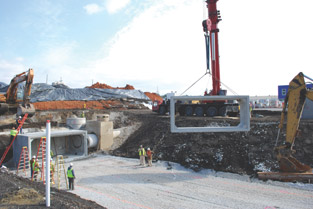
Box Sections for Culverts, Storm Drains and Sewers
Since the late 1970s, precast box sections have become an important component in the construction of culverts, storm drains and sewers, but there has not been a comprehensive standard for the installation of such sections. A new ASTM International standard fills this gap. C1675, Practice for Installation of Precast Reinforced Concrete Monolithic Box Sections for Culverts, Storm Drains and Sewers, was developed by Subcommittee C13.05 on Special Projects, part of ASTM International Committee C13 on Concrete Pipe.
"It is vitally important that all structural products be installed correctly in order to maintain the integrity of the engineer's design," says Oliver Delery, Hanson Pipe and Precast, LLC, and chairman, C13. "This is especially true for underground box culverts and pipe, as they must perform exactly like bridges. Our committee action, with the adoption of C1675, completes the design-installation package."
Part of the appeal of precast concrete boxes is that they can be installed quickly and easily, even in adverse weather conditions. Installation can be accomplished directly from delivery trucks or from stockpiled products.
"Precast box sections are products whose use is still growing and evolving," says Roman Selig, national account manager for concrete products, Hamilton Kent LLC, and chairman of C13.05. "New uses for box sections are being developed as time goes on. They're not just for culverts anymore."
Current applications for precast box sections include:
- Culverts;
- Storm sewers;
- Underground detention systems;
- Bridges;
- Pedestrian tunnels;
- Animal crossings;
- Lift station wet wells;
- Golf cart tunnels;
- Chambers or tunnels for underground utilities.
Despite this wide variety of uses, Selig notes that some design engineers are still not familiar with the versatility of precast box sections."C1675 will allow those people to better understand the product and how to use it by providing a uniform and consistent installation method," says Selig. "In addition, It will also benefit those who already have experience with the product."
The new standard will be used by specifiers and owners who now have an installation standard to reference; contractors, who will use it for installation guidance; and manufacturers, who can recommend C1675 to specifiers and contractors.
To purchase ASTM standards, visit www.astm.org and search by the standard designation, or contact ASTM Sales (phone: 877-909-ASTM; sales@astm.org).
CONTACT Technical Information: Roman Selig, Hamilton Kent LLC • Birmingham, Ala. • Phone: 205-910-0690 | ASTM Staff: Diane Trinsey • Phone: 610-832-9661
 SN Home
SN Home Archive
Archive Advertisers
Advertisers Masthead
Masthead RateCard
RateCard Subscribe
Subscribe Email Editor
Email Editor